Care Home Report: Safeguarding and Communication in Healthcare
VerifiedAdded on 2020/07/22
|6
|1478
|34
Report
AI Summary
This report provides a comprehensive overview of key aspects within a UK care home setting. It addresses equal opportunity, emphasizing the commitment to non-discrimination across various demographics. The report also explores how care homes meet specific service user needs through tailored treatments and the use of modern technologies, while adhering to health and safety regulations, including the HASAW Act of 1974. Effective communication is highlighted as crucial for providing exceptional patient care, along with strategies to overcome communication barriers. The report also examines safeguarding practices to protect service users from harm and abuse, adhering to CQC regulations. Finally, the report discusses the importance of staff competence, accountability, and the practical application of skills gained through work experience, referencing relevant legislations, policies and sector skills.

FORM
1
1
Paraphrase This Document
Need a fresh take? Get an instant paraphrase of this document with our AI Paraphraser
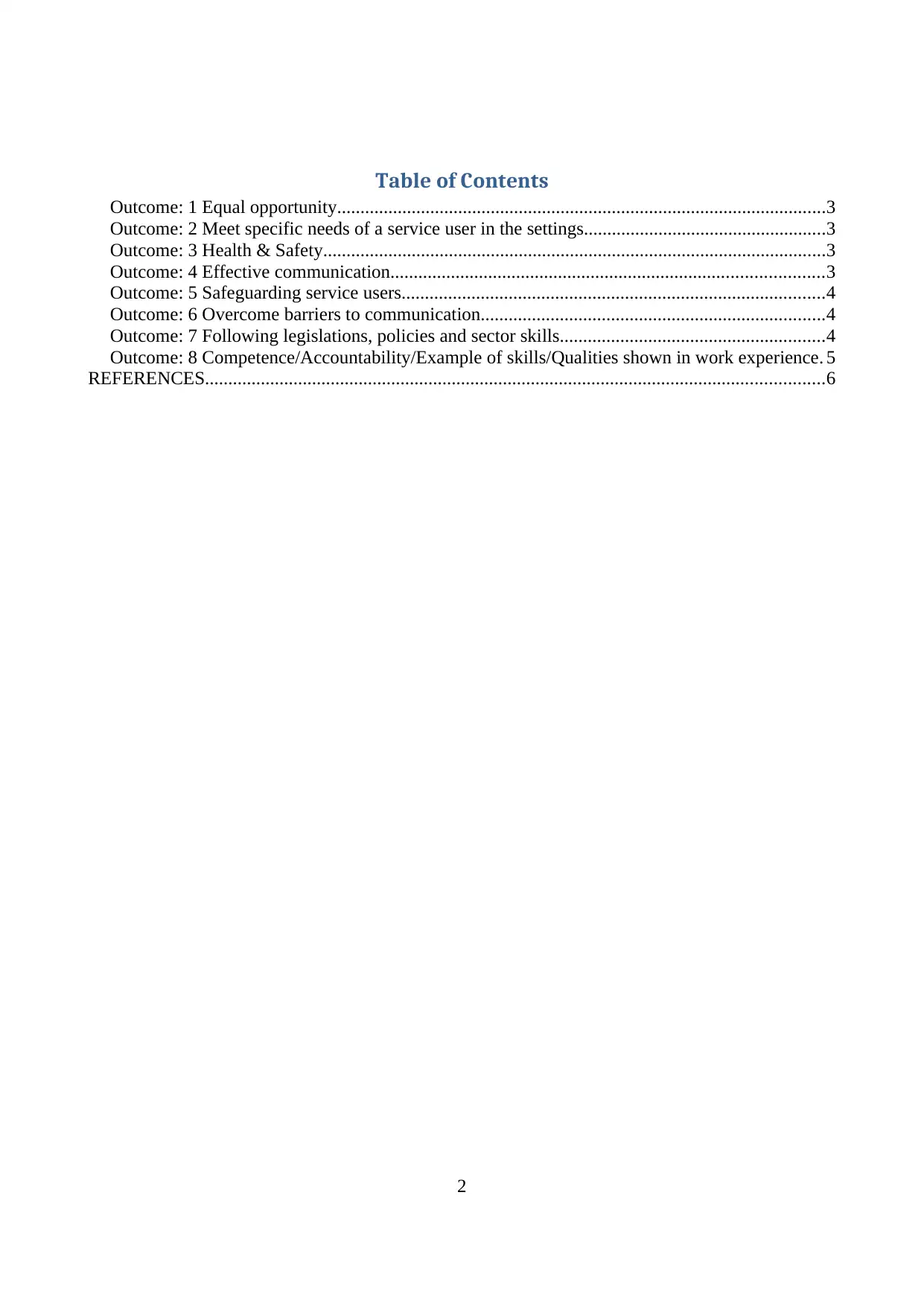
Table of Contents
Outcome: 1 Equal opportunity.........................................................................................................3
Outcome: 2 Meet specific needs of a service user in the settings....................................................3
Outcome: 3 Health & Safety............................................................................................................3
Outcome: 4 Effective communication.............................................................................................3
Outcome: 5 Safeguarding service users...........................................................................................4
Outcome: 6 Overcome barriers to communication..........................................................................4
Outcome: 7 Following legislations, policies and sector skills.........................................................4
Outcome: 8 Competence/Accountability/Example of skills/Qualities shown in work experience. 5
REFERENCES.....................................................................................................................................6
2
Outcome: 1 Equal opportunity.........................................................................................................3
Outcome: 2 Meet specific needs of a service user in the settings....................................................3
Outcome: 3 Health & Safety............................................................................................................3
Outcome: 4 Effective communication.............................................................................................3
Outcome: 5 Safeguarding service users...........................................................................................4
Outcome: 6 Overcome barriers to communication..........................................................................4
Outcome: 7 Following legislations, policies and sector skills.........................................................4
Outcome: 8 Competence/Accountability/Example of skills/Qualities shown in work experience. 5
REFERENCES.....................................................................................................................................6
2
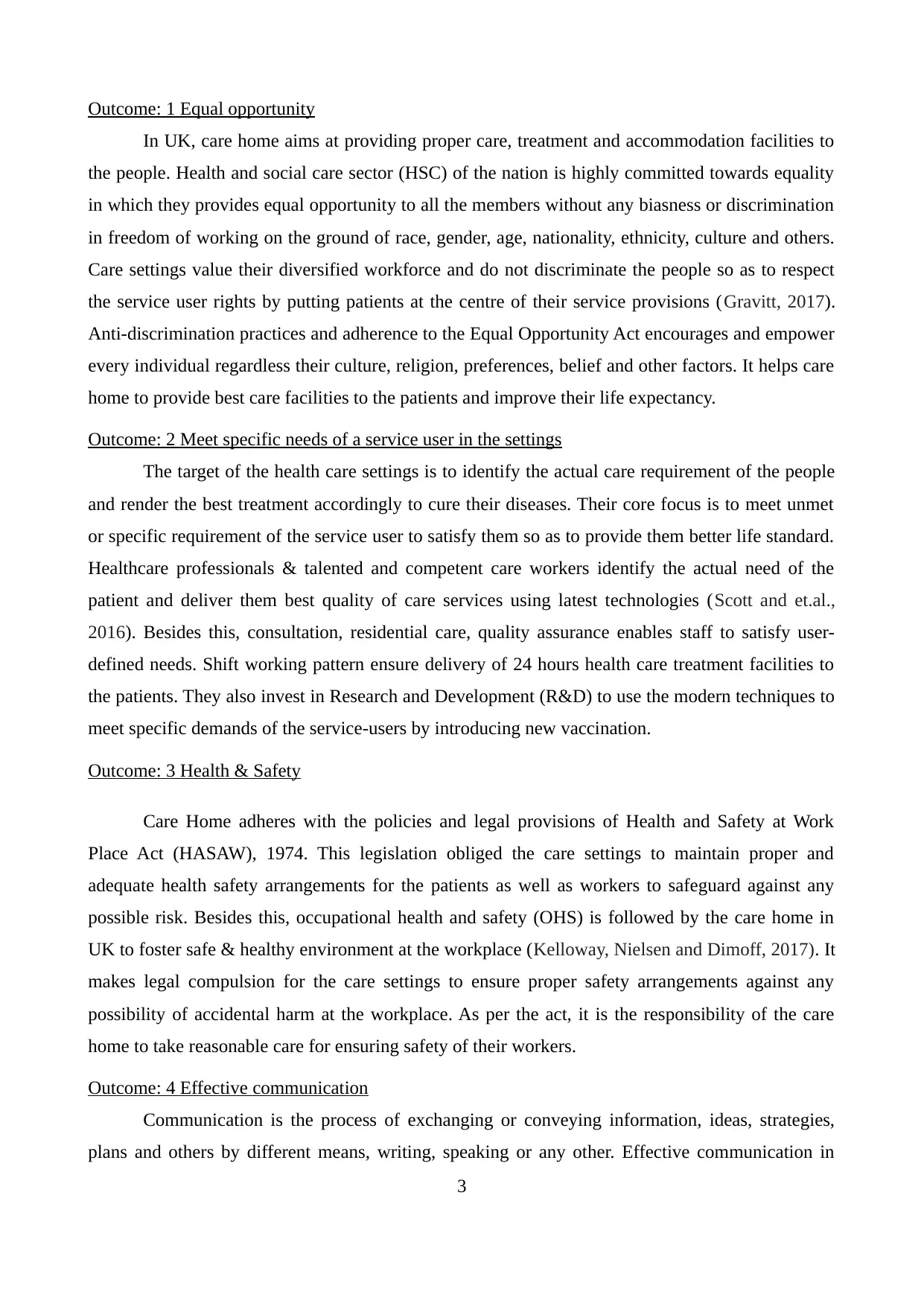
Outcome: 1 Equal opportunity
In UK, care home aims at providing proper care, treatment and accommodation facilities to
the people. Health and social care sector (HSC) of the nation is highly committed towards equality
in which they provides equal opportunity to all the members without any biasness or discrimination
in freedom of working on the ground of race, gender, age, nationality, ethnicity, culture and others.
Care settings value their diversified workforce and do not discriminate the people so as to respect
the service user rights by putting patients at the centre of their service provisions (Gravitt, 2017).
Anti-discrimination practices and adherence to the Equal Opportunity Act encourages and empower
every individual regardless their culture, religion, preferences, belief and other factors. It helps care
home to provide best care facilities to the patients and improve their life expectancy.
Outcome: 2 Meet specific needs of a service user in the settings
The target of the health care settings is to identify the actual care requirement of the people
and render the best treatment accordingly to cure their diseases. Their core focus is to meet unmet
or specific requirement of the service user to satisfy them so as to provide them better life standard.
Healthcare professionals & talented and competent care workers identify the actual need of the
patient and deliver them best quality of care services using latest technologies (Scott and et.al.,
2016). Besides this, consultation, residential care, quality assurance enables staff to satisfy user-
defined needs. Shift working pattern ensure delivery of 24 hours health care treatment facilities to
the patients. They also invest in Research and Development (R&D) to use the modern techniques to
meet specific demands of the service-users by introducing new vaccination.
Outcome: 3 Health & Safety
Care Home adheres with the policies and legal provisions of Health and Safety at Work
Place Act (HASAW), 1974. This legislation obliged the care settings to maintain proper and
adequate health safety arrangements for the patients as well as workers to safeguard against any
possible risk. Besides this, occupational health and safety (OHS) is followed by the care home in
UK to foster safe & healthy environment at the workplace (Kelloway, Nielsen and Dimoff, 2017). It
makes legal compulsion for the care settings to ensure proper safety arrangements against any
possibility of accidental harm at the workplace. As per the act, it is the responsibility of the care
home to take reasonable care for ensuring safety of their workers.
Outcome: 4 Effective communication
Communication is the process of exchanging or conveying information, ideas, strategies,
plans and others by different means, writing, speaking or any other. Effective communication in
3
In UK, care home aims at providing proper care, treatment and accommodation facilities to
the people. Health and social care sector (HSC) of the nation is highly committed towards equality
in which they provides equal opportunity to all the members without any biasness or discrimination
in freedom of working on the ground of race, gender, age, nationality, ethnicity, culture and others.
Care settings value their diversified workforce and do not discriminate the people so as to respect
the service user rights by putting patients at the centre of their service provisions (Gravitt, 2017).
Anti-discrimination practices and adherence to the Equal Opportunity Act encourages and empower
every individual regardless their culture, religion, preferences, belief and other factors. It helps care
home to provide best care facilities to the patients and improve their life expectancy.
Outcome: 2 Meet specific needs of a service user in the settings
The target of the health care settings is to identify the actual care requirement of the people
and render the best treatment accordingly to cure their diseases. Their core focus is to meet unmet
or specific requirement of the service user to satisfy them so as to provide them better life standard.
Healthcare professionals & talented and competent care workers identify the actual need of the
patient and deliver them best quality of care services using latest technologies (Scott and et.al.,
2016). Besides this, consultation, residential care, quality assurance enables staff to satisfy user-
defined needs. Shift working pattern ensure delivery of 24 hours health care treatment facilities to
the patients. They also invest in Research and Development (R&D) to use the modern techniques to
meet specific demands of the service-users by introducing new vaccination.
Outcome: 3 Health & Safety
Care Home adheres with the policies and legal provisions of Health and Safety at Work
Place Act (HASAW), 1974. This legislation obliged the care settings to maintain proper and
adequate health safety arrangements for the patients as well as workers to safeguard against any
possible risk. Besides this, occupational health and safety (OHS) is followed by the care home in
UK to foster safe & healthy environment at the workplace (Kelloway, Nielsen and Dimoff, 2017). It
makes legal compulsion for the care settings to ensure proper safety arrangements against any
possibility of accidental harm at the workplace. As per the act, it is the responsibility of the care
home to take reasonable care for ensuring safety of their workers.
Outcome: 4 Effective communication
Communication is the process of exchanging or conveying information, ideas, strategies,
plans and others by different means, writing, speaking or any other. Effective communication in
3
⊘ This is a preview!⊘
Do you want full access?
Subscribe today to unlock all pages.

Trusted by 1+ million students worldwide
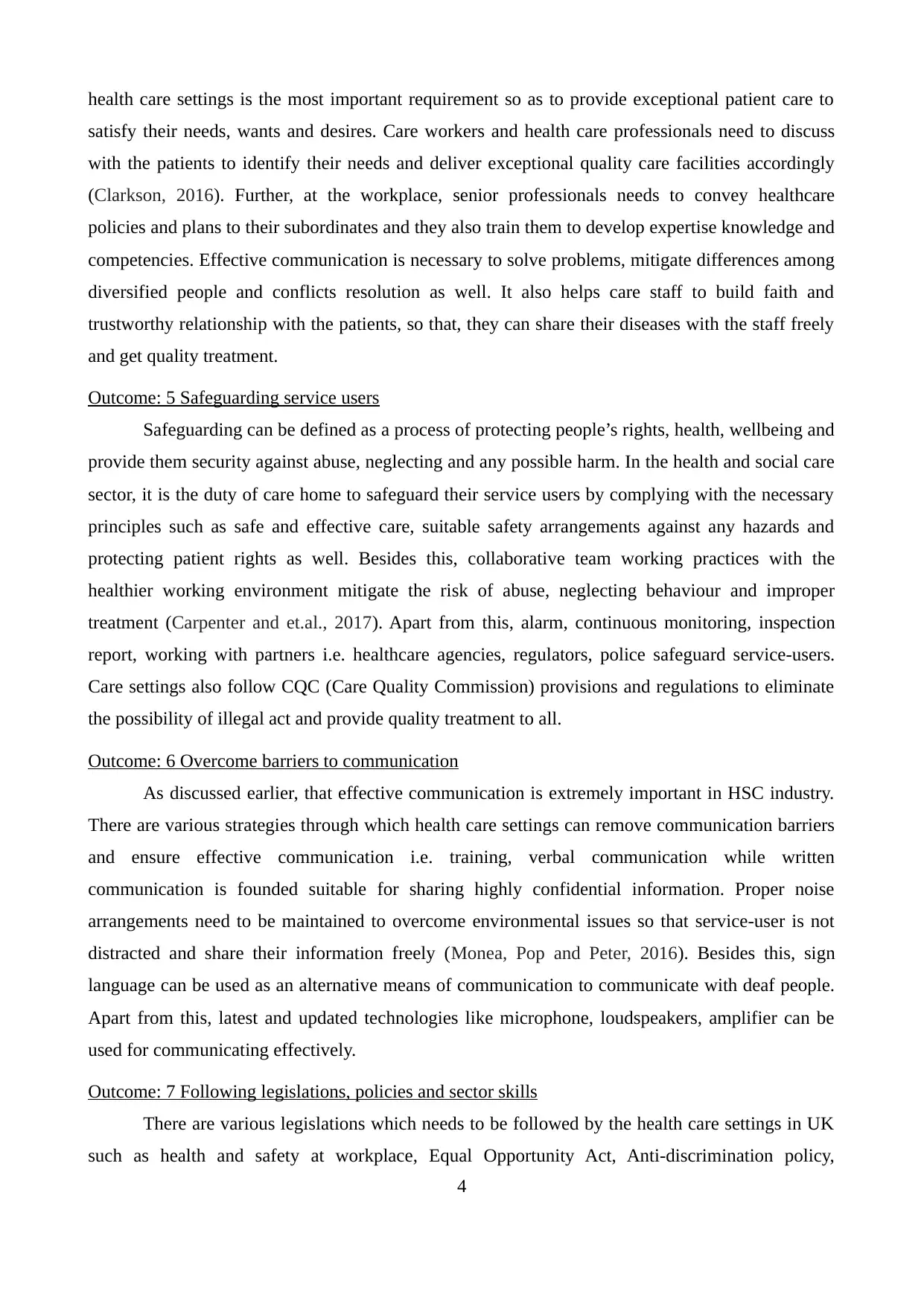
health care settings is the most important requirement so as to provide exceptional patient care to
satisfy their needs, wants and desires. Care workers and health care professionals need to discuss
with the patients to identify their needs and deliver exceptional quality care facilities accordingly
(Clarkson, 2016). Further, at the workplace, senior professionals needs to convey healthcare
policies and plans to their subordinates and they also train them to develop expertise knowledge and
competencies. Effective communication is necessary to solve problems, mitigate differences among
diversified people and conflicts resolution as well. It also helps care staff to build faith and
trustworthy relationship with the patients, so that, they can share their diseases with the staff freely
and get quality treatment.
Outcome: 5 Safeguarding service users
Safeguarding can be defined as a process of protecting people’s rights, health, wellbeing and
provide them security against abuse, neglecting and any possible harm. In the health and social care
sector, it is the duty of care home to safeguard their service users by complying with the necessary
principles such as safe and effective care, suitable safety arrangements against any hazards and
protecting patient rights as well. Besides this, collaborative team working practices with the
healthier working environment mitigate the risk of abuse, neglecting behaviour and improper
treatment (Carpenter and et.al., 2017). Apart from this, alarm, continuous monitoring, inspection
report, working with partners i.e. healthcare agencies, regulators, police safeguard service-users.
Care settings also follow CQC (Care Quality Commission) provisions and regulations to eliminate
the possibility of illegal act and provide quality treatment to all.
Outcome: 6 Overcome barriers to communication
As discussed earlier, that effective communication is extremely important in HSC industry.
There are various strategies through which health care settings can remove communication barriers
and ensure effective communication i.e. training, verbal communication while written
communication is founded suitable for sharing highly confidential information. Proper noise
arrangements need to be maintained to overcome environmental issues so that service-user is not
distracted and share their information freely (Monea, Pop and Peter, 2016). Besides this, sign
language can be used as an alternative means of communication to communicate with deaf people.
Apart from this, latest and updated technologies like microphone, loudspeakers, amplifier can be
used for communicating effectively.
Outcome: 7 Following legislations, policies and sector skills
There are various legislations which needs to be followed by the health care settings in UK
such as health and safety at workplace, Equal Opportunity Act, Anti-discrimination policy,
4
satisfy their needs, wants and desires. Care workers and health care professionals need to discuss
with the patients to identify their needs and deliver exceptional quality care facilities accordingly
(Clarkson, 2016). Further, at the workplace, senior professionals needs to convey healthcare
policies and plans to their subordinates and they also train them to develop expertise knowledge and
competencies. Effective communication is necessary to solve problems, mitigate differences among
diversified people and conflicts resolution as well. It also helps care staff to build faith and
trustworthy relationship with the patients, so that, they can share their diseases with the staff freely
and get quality treatment.
Outcome: 5 Safeguarding service users
Safeguarding can be defined as a process of protecting people’s rights, health, wellbeing and
provide them security against abuse, neglecting and any possible harm. In the health and social care
sector, it is the duty of care home to safeguard their service users by complying with the necessary
principles such as safe and effective care, suitable safety arrangements against any hazards and
protecting patient rights as well. Besides this, collaborative team working practices with the
healthier working environment mitigate the risk of abuse, neglecting behaviour and improper
treatment (Carpenter and et.al., 2017). Apart from this, alarm, continuous monitoring, inspection
report, working with partners i.e. healthcare agencies, regulators, police safeguard service-users.
Care settings also follow CQC (Care Quality Commission) provisions and regulations to eliminate
the possibility of illegal act and provide quality treatment to all.
Outcome: 6 Overcome barriers to communication
As discussed earlier, that effective communication is extremely important in HSC industry.
There are various strategies through which health care settings can remove communication barriers
and ensure effective communication i.e. training, verbal communication while written
communication is founded suitable for sharing highly confidential information. Proper noise
arrangements need to be maintained to overcome environmental issues so that service-user is not
distracted and share their information freely (Monea, Pop and Peter, 2016). Besides this, sign
language can be used as an alternative means of communication to communicate with deaf people.
Apart from this, latest and updated technologies like microphone, loudspeakers, amplifier can be
used for communicating effectively.
Outcome: 7 Following legislations, policies and sector skills
There are various legislations which needs to be followed by the health care settings in UK
such as health and safety at workplace, Equal Opportunity Act, Anti-discrimination policy,
4
Paraphrase This Document
Need a fresh take? Get an instant paraphrase of this document with our AI Paraphraser
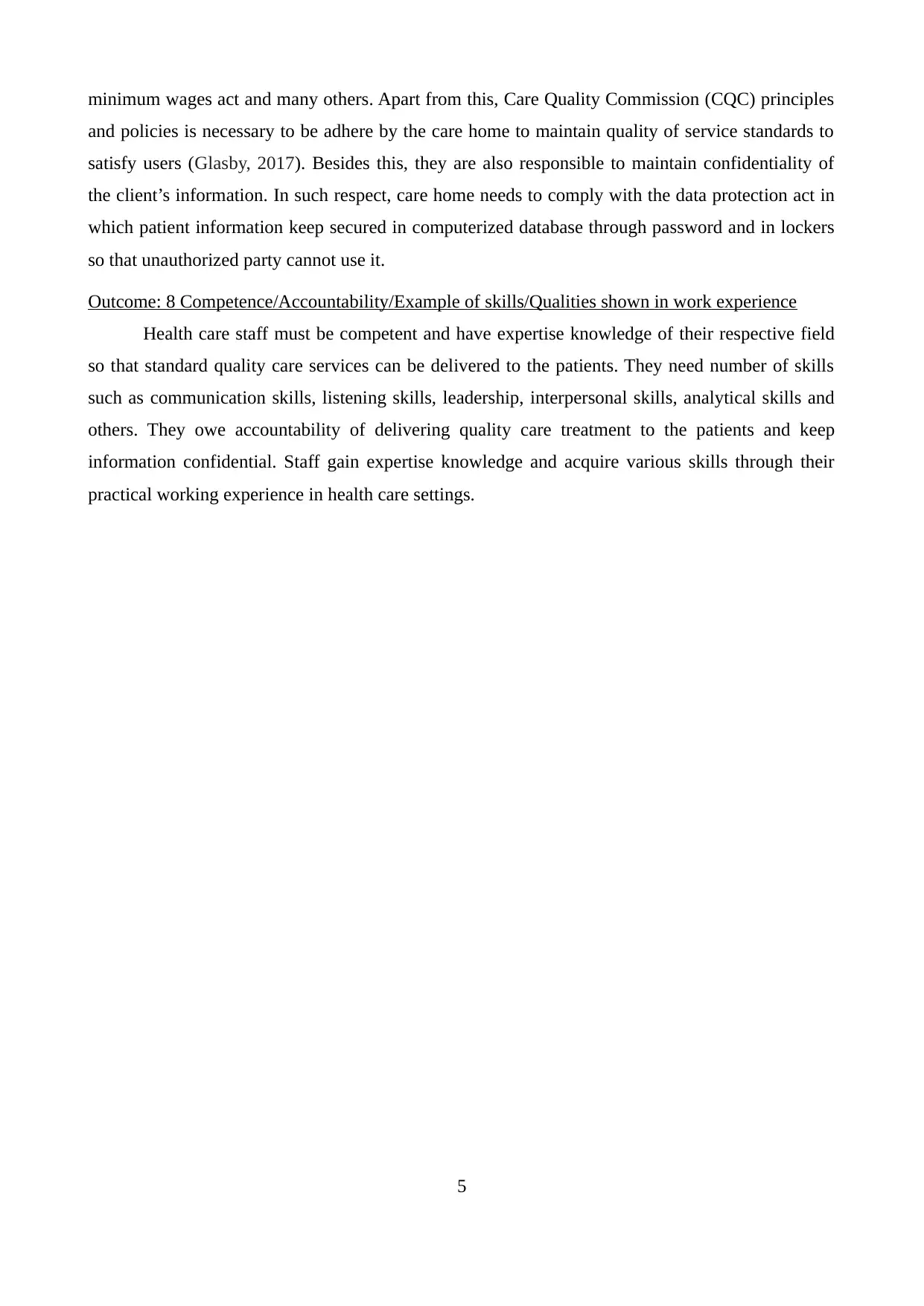
minimum wages act and many others. Apart from this, Care Quality Commission (CQC) principles
and policies is necessary to be adhere by the care home to maintain quality of service standards to
satisfy users (Glasby, 2017). Besides this, they are also responsible to maintain confidentiality of
the client’s information. In such respect, care home needs to comply with the data protection act in
which patient information keep secured in computerized database through password and in lockers
so that unauthorized party cannot use it.
Outcome: 8 Competence/Accountability/Example of skills/Qualities shown in work experience
Health care staff must be competent and have expertise knowledge of their respective field
so that standard quality care services can be delivered to the patients. They need number of skills
such as communication skills, listening skills, leadership, interpersonal skills, analytical skills and
others. They owe accountability of delivering quality care treatment to the patients and keep
information confidential. Staff gain expertise knowledge and acquire various skills through their
practical working experience in health care settings.
5
and policies is necessary to be adhere by the care home to maintain quality of service standards to
satisfy users (Glasby, 2017). Besides this, they are also responsible to maintain confidentiality of
the client’s information. In such respect, care home needs to comply with the data protection act in
which patient information keep secured in computerized database through password and in lockers
so that unauthorized party cannot use it.
Outcome: 8 Competence/Accountability/Example of skills/Qualities shown in work experience
Health care staff must be competent and have expertise knowledge of their respective field
so that standard quality care services can be delivered to the patients. They need number of skills
such as communication skills, listening skills, leadership, interpersonal skills, analytical skills and
others. They owe accountability of delivering quality care treatment to the patients and keep
information confidential. Staff gain expertise knowledge and acquire various skills through their
practical working experience in health care settings.
5
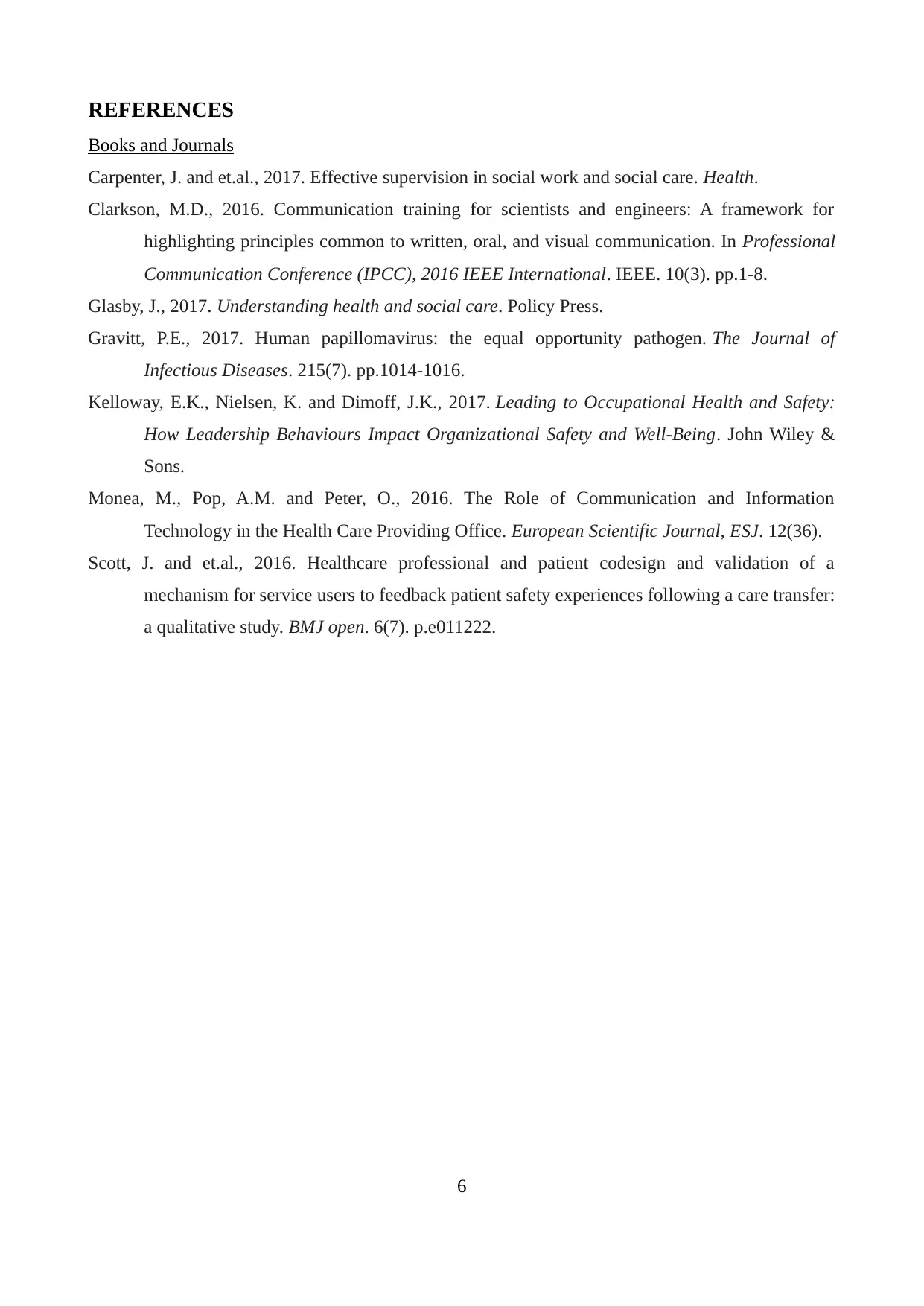
REFERENCES
Books and Journals
Carpenter, J. and et.al., 2017. Effective supervision in social work and social care. Health.
Clarkson, M.D., 2016. Communication training for scientists and engineers: A framework for
highlighting principles common to written, oral, and visual communication. In Professional
Communication Conference (IPCC), 2016 IEEE International. IEEE. 10(3). pp.1-8.
Glasby, J., 2017. Understanding health and social care. Policy Press.
Gravitt, P.E., 2017. Human papillomavirus: the equal opportunity pathogen. The Journal of
Infectious Diseases. 215(7). pp.1014-1016.
Kelloway, E.K., Nielsen, K. and Dimoff, J.K., 2017. Leading to Occupational Health and Safety:
How Leadership Behaviours Impact Organizational Safety and Well-Being. John Wiley &
Sons.
Monea, M., Pop, A.M. and Peter, O., 2016. The Role of Communication and Information
Technology in the Health Care Providing Office. European Scientific Journal, ESJ. 12(36).
Scott, J. and et.al., 2016. Healthcare professional and patient codesign and validation of a
mechanism for service users to feedback patient safety experiences following a care transfer:
a qualitative study. BMJ open. 6(7). p.e011222.
6
Books and Journals
Carpenter, J. and et.al., 2017. Effective supervision in social work and social care. Health.
Clarkson, M.D., 2016. Communication training for scientists and engineers: A framework for
highlighting principles common to written, oral, and visual communication. In Professional
Communication Conference (IPCC), 2016 IEEE International. IEEE. 10(3). pp.1-8.
Glasby, J., 2017. Understanding health and social care. Policy Press.
Gravitt, P.E., 2017. Human papillomavirus: the equal opportunity pathogen. The Journal of
Infectious Diseases. 215(7). pp.1014-1016.
Kelloway, E.K., Nielsen, K. and Dimoff, J.K., 2017. Leading to Occupational Health and Safety:
How Leadership Behaviours Impact Organizational Safety and Well-Being. John Wiley &
Sons.
Monea, M., Pop, A.M. and Peter, O., 2016. The Role of Communication and Information
Technology in the Health Care Providing Office. European Scientific Journal, ESJ. 12(36).
Scott, J. and et.al., 2016. Healthcare professional and patient codesign and validation of a
mechanism for service users to feedback patient safety experiences following a care transfer:
a qualitative study. BMJ open. 6(7). p.e011222.
6
⊘ This is a preview!⊘
Do you want full access?
Subscribe today to unlock all pages.

Trusted by 1+ million students worldwide
1 out of 6
Related Documents
Your All-in-One AI-Powered Toolkit for Academic Success.
+13062052269
info@desklib.com
Available 24*7 on WhatsApp / Email
![[object Object]](/_next/static/media/star-bottom.7253800d.svg)
Unlock your academic potential
Copyright © 2020–2025 A2Z Services. All Rights Reserved. Developed and managed by ZUCOL.





